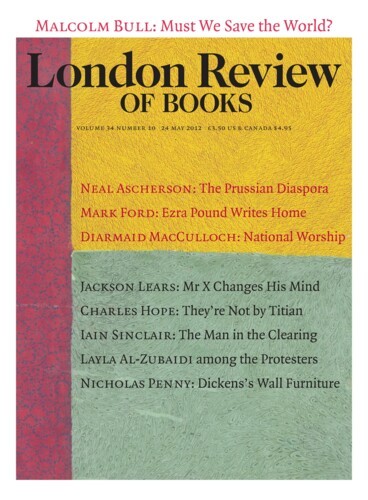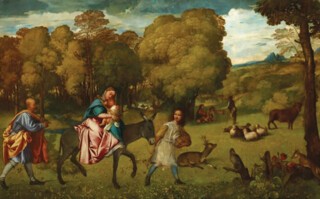The small exhibition at the National Gallery entitled Titian’s First Masterpiece: ‘The Flight into Egypt’, open until 19 August, is centred on a large canvas from the Hermitage. The picture has not been much discussed by scholars. This is partly because it has just emerged from a lengthy restoration, partly because it is known to most specialists mainly or only through photographs, and not least because it does not look much like any other painting generally accepted as by Titian. This is the first time in well over a century that the Flight has been seen outside Russia, and the first occasion on which it has been displayed with a substantial group of other works by the young Titian, several of them belonging to the National Gallery.
The Flight into Egypt was first mentioned by Giorgio Vasari, who is our main source of information about Venetian painting in the early years of the 16th century, although a very confusing and inadequate one. Vasari wrote in 1568 that Titian painted it after some frescoes on the outside of the German warehouse in Venice, which he implied, correctly, were done in or soon after 1507, adding that ‘it is in the house of Andrea Loredan who lives at San Marcuola.’ But by the time Vasari’s text was published, Loredan was dead and his family no longer lived in the very grand palace at San Marcuola built by their ancestor, also called Andrea. So presumably Vasari was relying here on recollections of his own visit to Venice in 1542, when Loredan was still alive, and not on information obtained more recently. At that early period, however, Vasari was not collecting material for a book, and much of what he later wrote about Venetian painting on the strength of his visit was demonstrably wrong.
Although the organisers describe the Hermitage picture as ‘certainly’ Titian’s ‘first masterpiece on a large scale’, the most striking thing to emerge from the exhibition is that it looks nothing like the National Gallery’s own paintings. It lacks the high finish, firm modelling and confident drawing that are consistent features of Titian’s best attested early works. The figures are strangely tentative and childish, and only the Madonna has any personality at all, a rather sentimental one. The landscape, on the other hand, is beautiful in places, and utterly different from that of any painting known to have been made in Venice in the first decade of the 16th century.
The dating of the picture has presented a particular problem to one of the organisers of the exhibition, Antonio Mazzotta, because he recently proposed that Titian’s famous Man with a Blue Sleeve, which belongs to the National Gallery, is a portrait of a member of the Barbarigo family described by Vasari, who said that it was painted before his frescoes and had helped him to obtain the commission. According to Vasari, then, the Barbarigo portrait was painted before the Flight into Egypt. But no one has even taken seriously the idea that Titian first painted the astonishingly assured Man with a Blue Sleeve and then the Flight. Even if we suppose that he painted the Man with a Blue Sleeve after the Flight, the pictures are so different that they cannot be very close in date. It is difficult to avoid the conclusion that either the Man with a Blue Sleeve is not the Barbarigo portrait, and was instead painted some years later, or the Flight is not by Titian.
The problem may not be evident to most visitors to the exhibition, simply because it is very hard, from the pictures on display, to gain a clear idea of what an early Titian looks like. This is a reflection of recent writing on the artist, in which the number and variety of pictures attributed to him have relentlessly increased. The reason is not that new information has come to light, but rather that he has been credited with pictures previously assigned to other artists, or not assigned to anyone at all. In other words, scholars have become more inclined to suppose that he changed his style quite radically almost from picture to picture. One consequence of this development is that, if we accept the estimates of some authorities, Titian in his early years was far more productive than any other Venetian painter of his time, and far more productive than at any later period in his career. Another consequence is that scholars are now completely unable to put the pictures generally accepted as being by the young Titian into a chronological sequence that commands widespread agreement.
One might have supposed that connoisseurship was a rigorous kind of activity, but this is something of a misconception, especially in the case of Venetian art of the Renaissance. For reasons that are never explained, but are perhaps not difficult to guess, there is considerable kudos attached to the process of upgrading previously neglected pictures, but none at all to the process of downgrading. Great weight is also attached to the views of experts (who are not always disinterested), but much less to the evidence on which those views are based, if evidence is provided at all. And of course, despite claims of objectivity, the institutions that own paintings would be happier to believe that they are by a famous artist than by some obscure figure of whom we know nothing.
Just how much reliance is placed on connoisseurship is shown by the case of Titian’s contemporary Giorgione, who died in 1510. None of his known pictures is signed, and by the 1540s there was already uncertainty about what his work looked like, which increased dramatically over the following centuries. In fact, there are only three paintings known today for which there is clear and credible early evidence that they were by him. Despite this, he is now generally credited with between twenty and forty paintings. But most of these, including the ones in the exhibition, bear no resemblance to the three just mentioned. Some of them might be by Giorgione, but in most cases there is no way of telling.
There is nothing about any of these problems in the captions to the exhibition or in the accompanying book, Mazzotta’s Titian: A Fresh Look at Nature (National Gallery, £9.99). Instead, it is simply assumed that Vasari was right about the attribution of the Flight, and wrong about the date. But he may have been wrong about both. It is also stated without qualification that the Flight was painted for Andrea Loredan. This too cannot be substantiated. Nor will most visitors be aware that over the past century and a half the attribution of almost every picture on display has been disputed, and that our confidence in the attributions proposed today may well be misplaced.
Several of the pictures credited to Titian in the exhibition seem very problematic. A weak and damaged picture of a young woman from the Norton Simon Collection looks utterly different from the two portraits from the National Gallery, both of which are signed, and which, we are told, date respectively from before and after the Simon picture. A portrait of a man from Alnwick also looks dismal and unconvincing beside the National Gallery portraits, while another portrait from Ickworth is too badly damaged to permit any decision at all. Then there is a small Holy Family from Longleat. This is often accepted as by Titian, and the figures, which are exceedingly badly drawn, are the closest thing in the exhibition to those in The Flight into Egypt. But why should we accept the Longleat picture, any more than the Flight? My own view is that the Flight was painted at least a decade or so later than is now believed, and that no part of it is by Titian.
The problem of the exhibition is not the content, but the way in which it is presented. The rationale for the loan was to show the Flight in the context of pictures by the young Titian and others. Since it does not look like many of those pictures, the attribution depends mainly on the authority of Vasari, but he also says things that seem to contradict that attribution. The case of the dating has already been mentioned. Vasari also refers to a small altarpiece by Titian in Venice and states explicitly that it was painted before the frescoes. It looks nothing like the Flight, and Mazzotta, like others before him, simply discounts Vasari’s testimony and dates the altarpiece much later. Vasari may have been wrong here, but it would have been more instructive for the public if known facts had been more clearly distinguished from speculation and wishful thinking. Why not admit that we still don’t know very much about Venetian painting in the first decade of the 16th century, instead of pretending to a knowledge that we do not possess?
Send Letters To:
The Editor
London Review of Books,
28 Little Russell Street
London, WC1A 2HN
letters@lrb.co.uk
Please include name, address, and a telephone number.


